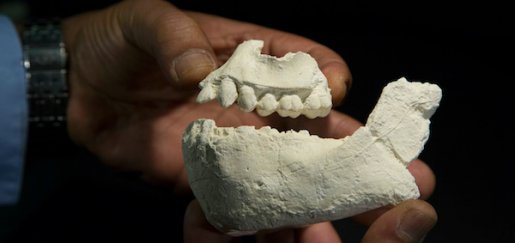Researchers have confirmed that a new hominin ancestor lived in Ethiopia between 3.3 and 3.5 million years ago, at the same time as the 'Lucy' species, Australopithecus afarensis.
The discovery, which has been described today in the journal Science, sheds new light on how modern humans evolved, and shows that the process of how we came to be was more complex than previously thought.
"The new species is yet another confirmation that Lucy's species, Australopithecus afarensis, was not the only potential human ancestor species that roamed in what is now the Afar region of Ethiopia during the middle Pliocene," lead author, Yohannes Haile-Selassie, from the Cleveland Museum of Natural History in the US, said in a press release. "Current fossil evidence from the Woranso-Mille study area clearly shows that there were at least two, if not three, early human species living at the same time and in close geographic proximity."
The new species was identified from a series of teeth and jaw bones that were discovered in 2011 in the central Afar region of Ethiopia, just 35 kilometres (22 miles) from the remains of 'Lucy', one of the most complete hominin skeletons ever discovered.
However, the thick-enameled teeth were a different shape and size to those of Lucy, suggesting the two individuals had different diets. The lower jaws were also far more robust then jawline of A. afarensis, leading the researchers to classify the remains as a new species, which they've called Australopithecus deyiremada - deyiremada is taken from words that mean "close relative" in the language of the Afar people.
The team then looked at the sediment on the remains, and used radiometric dating and palaeomagnetic data to work out when the new species lived. For decades, scientists have debated over the whether there was more than one hominin species living at a time between 3 and 4 million years ago. Up until the end of the 20th century, all the fossil evidence pointed to the fact that one species existed at a time before giving rise to another hominin.
But in 1995, a hominin species Australopithecus bahrelghazali was discovered in Chad and in 1999 scientists found Kenyanthropus platyops in Kenya - both of which were reported to have lived at the same time as Lucy. Those discoveries were met with skepticism, but this new find, along with a handful of other finds over the past 16 years, adds more weight to the idea that the evolution of Homo sapiens wasn't a straight line from A. afarensis.
 Yohannes Haile-Selassie/Cleveland Museum of Natural History
Yohannes Haile-Selassie/Cleveland Museum of Natural History
"This new species from Ethiopia takes the ongoing debate on early hominin diversity to another level," said Haile-Selassie. "Some of our colleagues are going to be skeptical about this new species, which is not unusual. However, I think it is time that we look into the earlier phases of our evolution with an open mind and carefully examine the currently available fossil evidence rather than immediately dismissing the fossils that do not fit our long-held hypotheses."
The challenge now is convincing the skeptics that A. deyiremada is indeed a separate species to Lucy - something that's pretty difficult given that we don't know much about how our ancestors looked or behaved. Haile-Selassie admits that it's impossible to even know if the two species would have even interacted.
Human palaeontologist Fred Spoor from the University College London in the UK, who worked on the discovery of Kenyanthropus platyops back in 1999, but wasn't involved in this research, told Arielle Duhaime-Ross over at The Verge that further evidence is needed before the debate is put to rest once and for all. "They give good reasons for why it's a different species, but I will only completely agree with it when I see it myself," he said.
Hopefully in the coming years we'll find out more about where we came from, but for now, we're pretty excited to add another species to our family tree.
